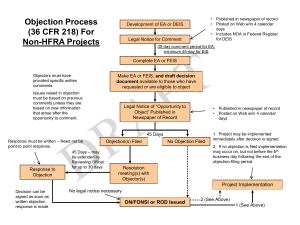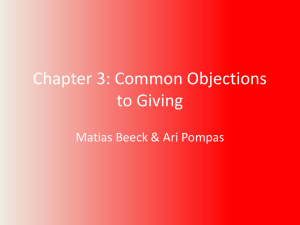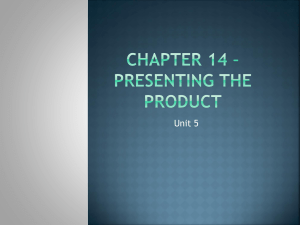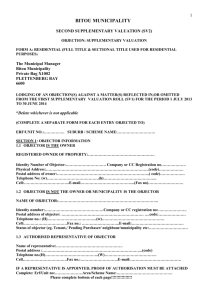Objections Fact Sheet - Save the Scenic Santa Ritas
advertisement
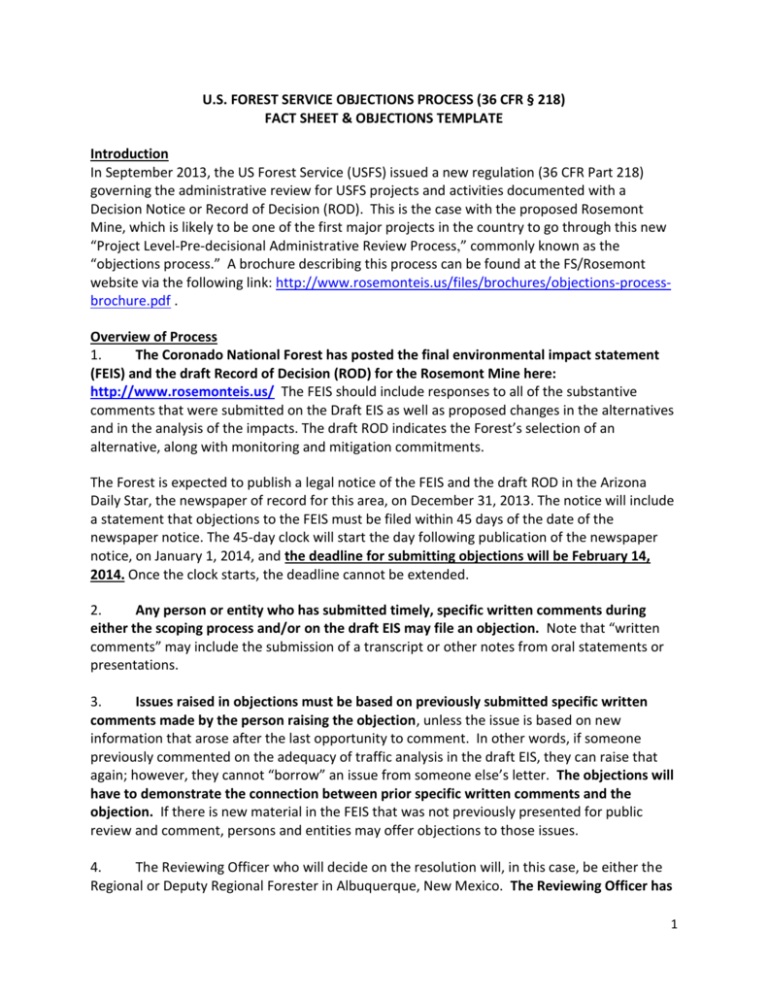
U.S. FOREST SERVICE OBJECTIONS PROCESS (36 CFR § 218) FACT SHEET & OBJECTIONS TEMPLATE Introduction In September 2013, the US Forest Service (USFS) issued a new regulation (36 CFR Part 218) governing the administrative review for USFS projects and activities documented with a Decision Notice or Record of Decision (ROD). This is the case with the proposed Rosemont Mine, which is likely to be one of the first major projects in the country to go through this new “Project Level-Pre-decisional Administrative Review Process,” commonly known as the “objections process.” A brochure describing this process can be found at the FS/Rosemont website via the following link: http://www.rosemonteis.us/files/brochures/objections-processbrochure.pdf . Overview of Process 1. The Coronado National Forest has posted the final environmental impact statement (FEIS) and the draft Record of Decision (ROD) for the Rosemont Mine here: http://www.rosemonteis.us/ The FEIS should include responses to all of the substantive comments that were submitted on the Draft EIS as well as proposed changes in the alternatives and in the analysis of the impacts. The draft ROD indicates the Forest’s selection of an alternative, along with monitoring and mitigation commitments. The Forest is expected to publish a legal notice of the FEIS and the draft ROD in the Arizona Daily Star, the newspaper of record for this area, on December 31, 2013. The notice will include a statement that objections to the FEIS must be filed within 45 days of the date of the newspaper notice. The 45-day clock will start the day following publication of the newspaper notice, on January 1, 2014, and the deadline for submitting objections will be February 14, 2014. Once the clock starts, the deadline cannot be extended. 2. Any person or entity who has submitted timely, specific written comments during either the scoping process and/or on the draft EIS may file an objection. Note that “written comments” may include the submission of a transcript or other notes from oral statements or presentations. 3. Issues raised in objections must be based on previously submitted specific written comments made by the person raising the objection, unless the issue is based on new information that arose after the last opportunity to comment. In other words, if someone previously commented on the adequacy of traffic analysis in the draft EIS, they can raise that again; however, they cannot “borrow” an issue from someone else’s letter. The objections will have to demonstrate the connection between prior specific written comments and the objection. If there is new material in the FEIS that was not previously presented for public review and comment, persons and entities may offer objections to those issues. 4. The Reviewing Officer who will decide on the resolution will, in this case, be either the Regional or Deputy Regional Forester in Albuquerque, New Mexico. The Reviewing Officer has 1 45 days to respond to the objections. He or she may grant themselves a 30 day extension. During this resolution period, the Reviewing Officer may set up in-person meetings, conference calls, project site visits, etc. The Responsible Officer who made the initial decision (i.e., Supervisor Upchurch) is to be included in such activities. The Reviewing Officer will provide a written response to the objections. It need not be a point-by-point response and may consolidate objections. 5. A final decision on the Forest Service’s role regarding the proposed mine may be made no earlier than the fifth business day following the end of the objection process. This is the Forest Service’s final agency action – there is no administrative appeal. NOTE: A final decision by the Forest Service pertains only to decisions under the Forest Service’s authority. While the Forest Service has an independent duty to ensure that that the project complies with the Clean Water Act, the Corps of Engineers will make a separate decision on the proposed Clean Water Act permit as will any other federal, state, and local agencies with decisionmaking authority. Objector Eligibility Requirements Those who are eligible to object include Individuals and entities who have submitted timely, specific written comments regarding a proposed project or activity during any designated opportunity for public comment, including the scoping period. “Written comments” includes oral comments submitted and transcribed at a public hearing. If a previously submitted comment letter includes multiple entities and individuals as signatories, all signatories will be eligible to object based on those comments. For example, the Coalition’s DEIS comment letter listed a number of organizations and individuals as signatories. All the signatories will be eligible to object based on issues raised in that letter, plus any new information not previously available for comment. Comments received from the representative of an entity are considered those of the entity only. Members of an entity are not eligible to object in an individual capacity solely on the basis of their membership; members must have submitted comments on their own in order to be eligible to file an objection in an individual capacity. When an objection lists multiple individuals or entities, each individual or entity listed must meet these requirements and a “lead objector” must be identified. Individuals or entities listed on an objection that do not meet eligibility requirements will not be considered objectors. Objections from individuals or entities that do not meet the requirements will not be accepted and will be documented as such in the record. Other eligible objectors include Federally-recognized Indian Tribes if they submitted comments during Federal-Tribal consultations and Federal employees who meet the requirements in a non-official capacity, provided they comply with applicable conflict-of-interest rules. Federal agencies are not eligible to object. 2 Minimum Requirements for Objections Objections will largely be based on whether the Forest has responded adequately to comments previously submitted on the Draft EIS. Objections may also be based on new information that was not in the draft EIS and thus not previously available for public comment. Issues raised in objections must be based on previously submitted comments made by the person or entity raising the objections, unless the issue is based on new information that arose after opportunities to comment (e.g., information presented for the first time in an FEIS). At a minimum, objections must be filed in writing and include all of the following: 1. The Objector’s name, address, phone number, and signature. A scanned signature is acceptable for objections submitted electronically. 2. Identification of “lead objector” if more than one objector listed; otherwise, the first eligible objector on the list will be designated as the lead objector. The lead objector will represent the other listed objectors for the purposes of communication, written and otherwise, regarding the objection 3. The name of the proposed project, name and title of the responsible official, and name of the national forest and/or ranger district. 4. A description of those aspects of the proposed project addressed by the objection, including: a. specific issues related to the proposed project; b. if applicable, how the objector believes the environmental analysis or draft decision specifically violates law, regulation, or policy - showing a violation is not required c. suggested remedies that would resolve the objection d. supporting reasons for the reviewing officer to consider 5. A statement that demonstrates the connection between prior specific written comments on the particular proposed project or activity and the content of the objection, unless the objection concerns an issue that arose after the designated opportunity(ies) for comment. NOTE: Incorporation of documents by reference is not allowed. The only exceptions are the following list of items: 1) Federal law or regulation; 2) Forest Service directives and land management plans; 3) documents referenced in the draft EIS; and 4) comments previously submitted by the objector during public comment periods. These items may be referenced by date, page, and section of the cited document, along with a description of its content and applicability to the objection. All other documents must be included with the objection. REMEMBER: Issues raised in objections must be based on previously submitted comments regarding the proposed project or activity and attributed to the objector, unless the issue is based on new information that arose after the opportunities for comment. The burden is on the objector to demonstrate compliance with this requirement for objection issues; aside from 3 objections based on new information, the objector must demonstrate the connection between prior comments and the content of their objections. Overview: What to look for when reviewing the FEIS Objections will generally support two (2) overarching arguments. It will be helpful to keep these in mind as you review the FEIS: 1. The “procedural” argument: This is focused on the quality of the FEIS itself; the quality of the analysis, the soundness of the conclusions, etc. Remember to include in your comments the identification of any critical missing or incomplete information. 2. The “substantive” argument: This argument is focused on the significance of the impacts and the adequacy of the mitigation measures to offset those impacts. Review should focus on two specific types of information in the FEIS. This information will form the foundation of objections. 1. Responses to previously submitted comments. Review these responses for their adequacy. Consider these types of questions as you review this information: Did they provide a response at all? Does the response address the concerns you raised? Did they include the new analyses you called for? Did they fix the flaws you pointed out in the DEIS? Did they just provide a generalized response? 2. New information not previously subject to public comment. This information could come in the form of a change to an alternative not previously described or analyzed in the DEIS, mitigation measures that were not described in the DEIS, that sort of thing. We expect quite a bit of this. This is the first (and only) opportunity to comment on this information, so look at it through essentially the same lens as you did when drafting DEIS comments. 4 OBJECTIONS TEMPLATE [DATE] To: Cal Joyner, Southwestern Regional Forester USFS Southwestern Region 333 Broadway SE Albuquerque, NM 87102 Re: Formal Objection to Final Impact Statement and Draft Record of Decision for the Rosemont Copper Project: A Proposed Mining Operation, Coronado National Forest 1. ALL Objector[s]’ name[s] and address[es] (and telephone number, if available): Objector 1 Name, LEAD OBJECTOR* Objector 1 Address Objector 1 Telephone number (if available) Objector 2 Name Objector 2 Address Objector 2 Telephone number (if available) *Identifying a lead objector is required when more than one objector is listed; if not identified the reviewing officer will designate the first objector listed NOTE: All objectors must individually meet the objector eligibility requirements listed above. REMEMBER: objectors may only object to issues raised in their own previously submitted comments. 2. Name of the proposed project, name and title of the responsible official, and name of the national forest and/or ranger district: Project Name: Rosemont Copper Project: A Proposed Mining Operation Responsible Official: Jim Upchurch, Forest Supervisor National Forest, Ranger District: Coronado National Forest, Nogales Ranger District 3. Statement of objections 5 [You must include all of the following information for each potential objection you raise.] Objection 1: 1. A short statement of the issue(s) and/or part(s) of project to which your objection specifically applies. [For example, impacts to water resources, impacts to visual resources, bonding, mitigation, etc.] 2. Concise statement explaining the objection, with supporting reasons for reviewing officer to consider. [Important: you must attach all supporting documents that you cite.] 3. If applicable, how the objector believes the environmental analysis or draft decision specifically violates law, regulation, or policy [e.g., the Clean Water Act, the Endangered Species Act, the Clean Air Act, US Forest Service regulations, USFS Handbook policy, etc. This piece is not required.] 4. Suggested remedies that would resolve the objection (if any). For objections supporting the “procedural” argument (see above): Suggested remedies may include those that would make the FEIS analysis adequate under NEPA, e.g., additional analysis that needs to be done, correcting flaws in existing analysis, broadening boundaries of defined project area, etc. For objections supporting the “substantive” objections: Are there mitigation measures that could remedy certain types of impacts (not the mine as a whole but particular types of impacts)? Please identify. 5. A statement that clearly demonstrates the connection between prior specific written comments on the particular proposed project or activity and the content of the objection. This piece is very important. This doesn’t have to be a long statement, but should include a specific reference to the previous comments upon which the objection is based, including the page # of the DEIS comment letter. Objections based on new information not previously subject to public comment do not require this statement. Objection 2: [Answer the above 5 points for each objection you make.] 4. ALL Objector[s]’ Signatures Objector 1 Name and Signature Objector 2 Name and Signature 6


